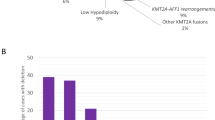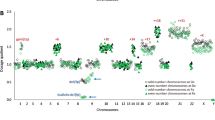Abstract
Intrachromosomal amplification of chromosome 21 (iAMP21) defines a distinct cytogenetic subgroup of childhood B-cell precursor acute lymphoblastic leukaemia (BCP-ALL). To date, fluorescence in situ hybridisation (FISH), with probes specific for the RUNX1 gene, provides the only reliable detection method (five or more RUNX1 signals per cell). Patients with iAMP21 are older (median age 9 years) with a low white cell count. Previously, we demonstrated a high relapse risk when these patients were treated as standard risk. Recent studies have shown improved outcome on intensive therapy. In view of these treatment implications, accurate identification is essential. Here we have studied the cytogenetics and outcome of 530 iAMP21 patients that highlighted the association of specific secondary chromosomal and genetic changes with iAMP21 to assist in diagnosis, including the gain of chromosome X, loss or deletion of chromosome 7, ETV6 and RB1 deletions. These iAMP21 patients when treated as high risk showed the same improved outcome as those in trial-based studies regardless of the backbone chemotherapy regimen given. This study reinforces the importance of intensified treatment to reduce the risk of relapse in iAMP21 patients. This now well-defined patient subgroup should be recognised by World Health Organisation (WHO) as a distinct entity of BCP-ALL.
This is a preview of subscription content, access via your institution
Access options
Subscribe to this journal
Receive 12 print issues and online access
$259.00 per year
only $21.58 per issue
Buy this article
- Purchase on Springer Link
- Instant access to full article PDF
Prices may be subject to local taxes which are calculated during checkout




Similar content being viewed by others
References
Harewood L, Robinson H, Harris R, Al Obaidi MJ, Jalali GR, Martineau M et al. Amplification of AML1 on a duplicated chromosome 21 in acute lymphoblastic leukemia: a study of 20 cases. Leukemia 2003; 17: 547–553.
Soulier J, Trakhtenbrot L, Najfeld V, Lipton JM, Mathew S, Avet-Loiseau H et al. Amplification of band q22 of chromosome 21, including AML1, in older children with acute lymphoblastic leukemia: an emerging molecular cytogenetic subgroup. Leukemia 2003; 17: 1679–1682.
Alvarez Y, Coll MD, Bastida P, Ortega JJ, Caballin MR . AML1 amplification in a child with acute lymphoblastic leukemia. Cancer Genet Cytogenet 2003; 140: 58–61.
Dube ID, el Solh H . An apparent tandem quadruplication of chromosome 21 in a case of childhood acute lymphoblastic leukemia. Cancer Genet Cytogenet 1986; 23: 253–256.
Le Coniat M, Romana SP, Berger R . Partial chromosome 21 amplification in a child with acute lymphoblastic leukemia. Genes Chromosomes Cancer 1995; 14: 204–209.
Busson-Le Coniat M, Nguyen KF, Daniel MT, Bernard OA, Berger R . Chromosome 21 abnormalities with AML1 amplification in acute lymphoblastic leukemia. Genes Chromosomes Cancer 2001; 32: 244–249.
Baialardo EM, Felice MS, Rossi J, Barreiro C, Gallego MS . Tandem triplication and quadruplication of chromosome 21 in childhood acute lymphoblastic leukemia. Cancer Genet Cytogenet 1996; 92: 43–45.
Niini T, Kanerva J, Vettenranta K, Saarinen-Pihkala UM, Knuutila S . AML1 gene amplification: a novel finding in childhood acute lymphoblastic leukemia. Haematologica 2000; 85: 362–366.
Dal Cin P, Atkins L, Ford C, Ariyanayagam S, Armstrong SA, George R et al. Amplification of AML1 in childhood acute lymphoblastic leukemias. Genes Chromosomes Cancer 2001; 30: 407–409.
Mathew S, Rao PH, Dalton J, Downing JR, Raimondi SC . Multicolor spectral karyotyping identifies novel translocations in childhood acute lymphoblastic leukemia. Leukemia 2001; 15: 468–472.
Morel F, Herry A, Le Bris MJ, Douet-Guilbert N, Le Calvez G, Marion V et al. AML1 amplification in a case of childhood acute lymphoblastic leukemia. Cancer Genet Cytogenet 2002; 137: 142–145.
Penther D, Preudhomme C, Talmant P, Roumier C, Godon A, Mechinaud F et al. Amplification of AML1 gene is present in childhood acute lymphoblastic leukemia but not in adult, and is not associated with AML1 gene mutation. Leukemia 2002; 16: 1131–1134.
Moorman AV, Robinson H, Schwab C, Richards SM, Hancock J, Mitchell CD et al. Risk-directed treatment intensification significantly reduces the risk of relapse among children and adolescents with acute lymphoblastic leukemia and intrachromosomal amplification of chromosome 21: a comparison of the MRC ALL97/99 and UKALL2003 trials. J Clin Oncol 2013; 31: 3389–3396.
Heerema NA, Carroll AJ, Devidas M, Loh ML, Borowitz MJ, Gastier-Foster JM et al. Intrachromosomal amplification of chromosome 21 is associated with inferior outcomes in children with acute lymphoblastic leukemia treated in contemporary standard-risk Children’s Oncology Group studies: a report from the Children’s Oncology Group. J Clin Oncol 2013; 31: 3397–3402.
Robinson HM, Broadfield ZJ, Cheung KL, Harewood L, Harris RL, Jalali GR et al. Amplification of AML1 in acute lymphoblastic leukemia is associated with a poor outcome. Leukemia 2003; 17: 2249–2250.
Moorman AV, Richards SM, Robinson HM, Strefford JC, Gibson BE, Kinsey SE et al. Prognosis of children with acute lymphoblastic leukemia (ALL) and intrachromosomal amplification of chromosome 21 (iAMP21). Blood 2007; 109: 2327–2330.
Attarbaschi A, Mann G, Panzer-Grumayer R, Rottgers S, Steiner M, Konig M et al. Minimal residual disease values discriminate between low and high relapse risk in children with B-cell precursor acute lymphoblastic leukemia and an intrachromosomal amplification of chromosome 21: the Austrian and German acute lymphoblastic leukemia Berlin-Frankfurt-Munster (ALL-BFM) trials. J Clin Oncol 2008; 26: 3046–3050.
Rand V, Parker H, Russell LJ, Schwab C, Ensor H, Irving J et al. Genomic characterization implicates iAMP21 as a likely primary genetic event in childhood B-cell precursor acute lymphoblastic leukemia. Blood 2011; 117: 6848–6855.
Robinson HM, Harrison CJ, Moorman AV, Chudoba I, Strefford JC . Intrachromosomal amplification of chromosome 21 (iAMP21) may arise from a breakage-fusion-bridge cycle. Genes Chromosomes Cancer 2007; 46: 318–326.
Strefford JC, Van Delft FW, Robinson HM, Worley H, Yiannikouris O, Selzer R et al. Complex genomic alterations and gene expression in acute lymphoblastic leukemia with intrachromosomal amplification of chromosome 21. Proc Natl Acad Sci USA 2006; 103: 8167–8172.
Kuchinskaya E, Nordgren A, Heyman M, Schoumans J, Corcoran M, Staaf J et al. Tiling-resolution array-CGH reveals the pattern of DNA copy number alterations in acute lymphoblastic leukemia with 21q amplification: the result of telomere dysfunction and breakage/fusion/breakage cycles? Leukemia 2007; 21: 1327–1330.
Sinclair PB, Parker H, An Q, Rand V, Ensor H, Harrison CJ et al. Analysis of a breakpoint cluster reveals insight into the mechanism of intrachromosomal amplification in a lymphoid malignancy. Hum Mol Genet 2011; 20: 2591–2602.
Harrison CJ . Cytogenetics of paediatric and adolescent acute lymphoblastic leukaemia. Br J Haematol 2009; 144: 147–156.
Harrison CJ, Haas O, Harbott J, Biondi A, Stanulla M, Trka J et al. Detection of prognostically relevant genetic abnormalities in childhood B-cell precursor acute lymphoblastic leukaemia: recommendations from the Biology and Diagnosis Committee of the International Berlin-Frankfurt-Munster study group. Br J Haematol 2010; 151: 132–142.
Arico M, Schrappe M, Hunger SP, Carroll WL, Conter V, Galimberti S et al. Clinical outcome of children with newly diagnosed Philadelphia chromosome-positive acute lymphoblastic leukemia treated between 1995 and 2005. J Clin Oncol 2010; 28: 4755–4761.
Schrappe M, Hunger SP, Pui CH, Saha V, Gaynon PS, Baruchel A et al. Outcomes after induction failure in childhood acute lymphoblastic leukemia. N Engl J Med 2012; 366: 1371–1381.
Bungaro S, Dell'Orto MC, Zangrando A, Basso D, Gorletta T, Lo Nigro L et al. Integration of genomic and gene expression data of childhood ALL without known aberrations identifies subgroups with specific genetic hallmarks. Genes Chromosomes Cancer 2009; 48: 22–38.
ISCN. An International System for Human Cytogenetic Nomenclature, In: Shaffer LG, Slovak ML, Campbell LJ (eds). S. Karger: Basel, 2009.
Harrison CJ, Moorman AV, Barber KE, Broadfield ZJ, Cheung KL, Harris RL et al. Interphase molecular cytogenetic screening for chromosomal abnormalities of prognostic significance in childhood acute lymphoblastic leukaemia: a UK Cancer Cytogenetics Group Study. Br J Haematol 2005; 129: 520–530.
Schwab CJ, Jones LR, Morrison H, Ryan SL, Yigittop H, Schouten JP et al. Evaluation of multiplex ligation-dependent probe amplification as a method for the detection of copy number abnormalities in B-cell precursor acute lymphoblastic leukemia. Genes Chromosomes Cancer 2010; 49: 1104–1113.
Moorman AV, Richards SM, Martineau M, Cheung KL, Robinson HM, Jalali GR et al. Outcome heterogeneity in childhood high-hyperdiploid acute lymphoblastic leukemia. Blood 2003; 102: 2756–2762.
Sutcliffe MJ, Shuster JJ, Sather HN, Camitta BM, Pullen J, Schultz KR et al. High concordance from independent studies by the Children’s Cancer Group (CCG) and Pediatric Oncology Group (POG) associating favorable prognosis with combined trisomies 4, 10, and 17 in children with NCI standard-risk B-precursor acute lymphoblastic leukemia: a Children's Oncology Group (COG) initiative. Leukemia 2005; 19: 734–740.
Haltrich I, Csoka M, Kovacs G, Torok D, Alpar D, Ottoffy G et al. Six cases of rare gene amplifications and multiple copy of fusion gene in childhood acute lymphoblastic leukemia. Pathol Oncol Res 2013; 19: 123–128.
Schwab CJ, Chilton L, Morrison H, Jones L, Al-Shehhi H, Erhorn A et al. Genes commonly deleted in childhood B-cell precursor acute lymphoblastic leukemia: association with cytogenetics and clinical features. Haematologica 2013; 98: 1081–1088.
Broadfield ZJ, Hain RD, Harrison CJ, Reza JG, McKinley M, Michalova K et al. Complex chromosomal abnormalities in utero, 5 years before leukaemia. Br J Haematol 2004; 126: 307–312.
Ma SK, Wan TS, Cheuk AT, Fung LF, Chan GC, Chan SY et al. Characterization of additional genetic events in childhood acute lymphoblastic leukemia with TEL/AML1 gene fusion: a molecular cytogenetics study. Leukemia 2001; 15: 1442–1447.
Acknowledgements
We thank the member laboratories of the UK Cancer Cytogenetics Group, the National Cancer Research Institute and Childhood Leukaemia Subgroup, UK, those cytogenetics laboratories contributing to the COG trails in the United States and all other participating cytogenetics laboratories and treating physicians worldwide. We are grateful for financial support from Leukaemia and Lymphoma Research, Grants CA13539 and CA98543 from the National Institutes of Health to the COG, Swedish Childhood Cancer Foundation, FWO-Vlaanderen, Vlaamse liga tegen Kanker and NKP 29-020, Jubilämsfonds Österreichische Nationalbank (ÖNB No. 14133).
Author contributions
CJH, OAH and AVM designed the study. CJH and AVM organised data collection. CJH and CS analysed the cytogenetic, FISH and MLPA data. CS, AJC and NAH reviewed the cytogenetic data. CS, SS and KN carried out and interpreted the MLPA data. CS, AJC, EAR, MD, SS, KN, JH, AT-S, MZ, ND, AB, JS, M-FA, AA, GM, BS, GC, LC, PV, EF, IH, SCR, MP, J-PB, JT, CH, AV, SPH, NAH and OAH contributed cytogenetic, FISH and/or SNP data and/or clinical and follow-up data. CJH, AVM, SPH and OAH wrote the manuscript that was critically reviewed by all authors.
Author information
Authors and Affiliations
Consortia
Corresponding author
Ethics declarations
Competing interests
The authors declare no conflict of interest.
Additional information
Supplementary Information accompanies this paper on the Leukemia website
Supplementary information
Rights and permissions
About this article
Cite this article
Harrison, C., Moorman, A., Schwab, C. et al. An international study of intrachromosomal amplification of chromosome 21 (iAMP21): cytogenetic characterization and outcome. Leukemia 28, 1015–1021 (2014). https://doi.org/10.1038/leu.2013.317
Received:
Revised:
Accepted:
Published:
Issue Date:
DOI: https://doi.org/10.1038/leu.2013.317
Keywords
This article is cited by
-
Measurable residual disease study through three different methods can anticipate relapse and guide early interventions in childhood acute lymphoblastic leukemia
Clinical and Translational Oncology (2023)
-
PersonALL: a genetic scoring guide for personalized risk assessment in pediatric B-cell precursor acute lymphoblastic leukemia
British Journal of Cancer (2023)
-
The complex karyotype in hematological malignancies: a comprehensive overview by the Francophone Group of Hematological Cytogenetics (GFCH)
Leukemia (2022)
-
Immunophenotypic challenges in diagnosis of CD79a negativity in a patient with B acute lymphoblastic leukemia harboring intrachromosomal amplification of chromosome 21: a case report
Journal of Medical Case Reports (2021)
-
Recurrent somatic mutations and low germline predisposition mutations in Korean ALL patients
Scientific Reports (2021)



